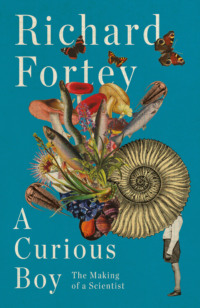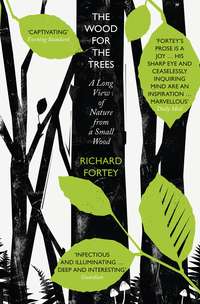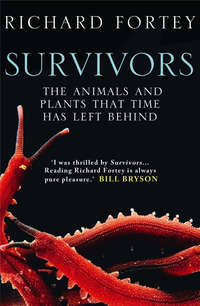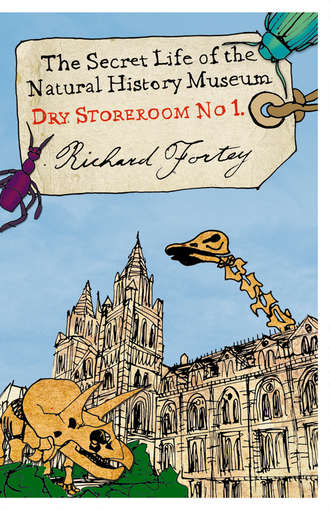
Полная версия
Dry Store Room No. 1: The Secret Life of the Natural History Museum
The writing on the labels does not betray any drama of discovery. Old labels like these are written in the hand of the curator at the time the specimen is identified. They are small slips, about the size of one of those special postage stamps issued by countries like San Marino. The writing has to be very neat. Old labels are frequently found written in the copperplate script preferred by the Victorians. Newer ones favour small, neat script. Everything is written in Indian ink so that time will not allow the messages to fade. After all, the 1753 Act of Parliament that set up the British Museum specified that the collections ‘shall remain and be preserved in the Museum for public use for all posterity’. These labels were meant to last. An old label is a message from a curator whom one might never have met, but a little personal message on paper nonetheless. There was a time when the hiring of curators was accompanied by a writing test; nobody with overly large writing would be employed, nor any scribblers, nor any who employed extravagant curlicues. Graphologists would have had a very dull time with those who came through the interviews. More recently, the computer has replaced the skilled human being, as so often, so that neat little labels can be spewed out of a laser printer at the touch of a button. In future, labels will always be impersonal (and if there is a mistake, probably nobody will know who made it). At the top of the label accompanying the large tooth is the Latin, or scientific, name of the animal concerned: Mammuthus primigenius – an ancient mammoth. Any visiting scientist will recognize that name. The rock formation from which it was recovered (Easton Bavents Formation) is given next. The age of the specimen within the Pleistocene period follows. Beneath this again is the locality, specified quite precisely. Nowadays a locality might well be given by a GPS position, but British specimens could be fairly precisely located by reference to the national grid, and I have seldom had a problem relocating a locality if this information was given. Then there is the name of the collector of the specimen, who also happened to donate it to the Museum ‘for all posterity’. Many labels will include more information, especially if the specimen to hand has been mentioned or figured in a scientific paper. This is how the importance of the material is conveyed to the outside world: not everybody can come to root around in the drawers of the Museum to see the specimens themselves. Specimens are made known to experts around the world primarily through catalogues and technical publications. So the label might also bear something like: ‘Figured by Ann T. Quarian in Transactions of the Society for Ancient Things Volume 1, Plate 1 figure 2’.
That is just one specimen taken at random from a single drawer in a rank of drawers in just one cupboard from one row of cabinets. Some drawers may contain a hundred specimens or more – the next one down includes tiny vole teeth, for example. There may be a dozen or more drawers in a single rank; and there are some ten ranks of drawers in a row. On this floor there are fifty-seven rows or lines of cabinets; except where very large specimens are accommodated, almost every drawer carries a full burden of specimens. In this department alone there are three floors of fossil collections of comparable or greater size. That adds up to a very large complement of drawers, and a vast number of specimens. It does not require a calculation to show that only a tiny fraction of the material held by the Museum is on display to the public: the galleries show the merest sample from a colossal collection. In the secret world behind the scenes there is no shortage of specimens; indeed, one of the main problems is how to accommodate the sheer bulk of new material. Much of it is fragmentary, like the Easton Bavents bones. Its value is scientific and it would not fetch much on the open market. A few specimens are precious and valuable in their own right. ‘Million dollar fossils’ might include the famous original of the Jurassic bird Archaeopteryx or the exquisitely preserved fossils of Cretaceous fishes from Brazil. But that is not why we have museums with collections of natural history specimens. A few scraps of bone can tell us what the climate was like three hundred thousand years ago: that is a value that cannot be reckoned in euros or dollars.
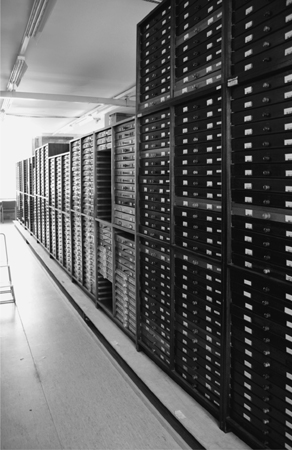
Countless specimens: rows of cabinets and drawers for storing the insect collection. In 2007 this storage was being replaced and renewed.
Museum cabinets. Photo © Natural History Museum, London.
My first office was not in the present palaeontology wing, which was officially opened in 1977 – by which time I was already an old hand. I originally had an office in the old building, tucked away in the basement beside the main entrance. On busy days I could hear the chattering of children as they swarmed up the steps. It was a hugely tall room, and not like an office at all, lit from a large window that looked out on to the lawn in front of the Museum. The collections – my part of the collections – were stored within the room in old storage cabinets. The office was so tall that it had an extra gallery halfway up, reached by a steel staircase. If I wanted to examine some part of the collections I would have to clunk up the stairs, carrying my hand lens, like an antiquarian gaoler, and open drawers in this upper storey. There were railings all around it to ensure that I did not fall off. The cabinets were beautifully crafted. Each drawer had an independently suspended glass top to keep out the dust. The mortise and tenon joints that formed the corners of the drawers would have struck dumb any carpenter. Labels on the front of each drawer recorded the scientific names of the fossils within. They were cupboards made for eternity. From my first day in that office I felt like an expert – the man from the BM.
I should explain that the Natural History Museum was then known in the scientific trade as the BM, the British Museum. The official title of the museum at the time of my employment was in fact the British Museum (Natural History). The South Kensington museum had split off from the original BM at Bloomsbury when the natural history collections had become so large as to require separate accommodation. The divorce from the mother institution was slow and legalistic. Formal separation from Bloomsbury did not happen until an Act of Parliament of 16 August 1965. The old BM title nonetheless had a magisterial presence that could not be instantly erased. My colleagues would call me up to make a date to ‘come to the BM’ as if that were the only way in which it could be referred to. At conferences, I would still describe myself as belonging to the British Museum – after all, there were other natural history museums all over the place but only one BM, which housed collections made by Sir Joseph Banks and Charles Darwin. However, since the public at large referred to it as the Natural History Museum, in 1990 that finally became its official title. Farewell to the BM, with the finality of the end of the gold sovereign or the landau carriage. Even so, some of my more senior colleagues still sneakily find themselves talking about ‘finding time to call in at the BM …’.
So there I was in my official premises, surrounded by the collections upon which I was to work and to which I was supposed to add. My contract had specified only that I ‘should undertake work upon the fossil Arthropoda’, which left me free to roam through hundreds of millions of years. It might as well have said: ‘Amuse yourself – for money.’ But I did have a boss to whom I was accountable. As I have mentioned, the head of department in a British national museum is called the Keeper. This may call up an image of a man in braces mucking out a gorilla cage, or it may have connotations of somebody jangling keys and going around inspecting security locks. It is, however, rather a grand title, one that entitles the bearer to an entry in Who’s Who. My boss, the Keeper of Palaeontology, was H. W. Ball – Harold William. Above a certain level in the hierarchy one was allowed to call him ‘Bill’; otherwise, it was always ‘Dr Ball’. He had the room directly above me, a place of leather-topped desks and filing cabinets. He was guarded by the kind of devoted secretary who exists mostly in the pages of spy novels, like the prim Miss Moneypenny in the James Bond thrillers. She was called Miss Belcher. She was an unmarried lady who lived with and cared for her mother; in the Palaeontology Department she was omniscient. Some years later, I discovered that her Christian name was Phoebe, but I would have no more dreamed of addressing her by that name than I would of addressing the Queen as ‘Lizzie’. She occupied an anteroom through which one had to pass to access the presence of the Keeper; and she always called him that, just as she always called me ‘Dr Fortey’ until she retired. She regarded such access as a rare and precious commodity, and an audience was a privilege to be awarded reluctantly. In fact, one usually went to see the Keeper because one was summoned. Few employees dropped in for a chinwag.
Occasionally, the summons was for doing something naughty. It was easy to anticipate these occasions. Normally, Dr Ball gestured towards a chair, beaming, and said something like: ‘Sit ye down, dear boy.’ He had a slightly polished-up, satisfied air, like the head boy of a posh school. On the other hand, if you had transgressed one of the rules, you earned a particular stare that P. G. Wodehouse described as ‘basilisk’ when emanating from one of Bertie Wooster’s more terrifying aunts. Once I was ticked off for the key offence – leaving them displayed to the world upon my desk. Then there was a diary infringement. The diary was a hangover from the early days of the Museum, being a little book into which the employee was supposed to write his activities, morning and afternoon, and which was collected every month and signed off by the head of department. It was a very tedious bit of bureaucracy, and nobody on the shop floor took it seriously. I took to writing ‘study trilobites’ on the first day of the month and ditto marks for the rest of it. Miss Belcher called me up to say that the Keeper didn’t regard this as adequate, and would I please put in more details. So the following month I put in entries like ‘a.m. open envelopes’ and ‘p.m. post replies’ and at the end of the month: ‘p.m. write diary’. My attempts at humour were not appreciated upstairs. The Keeper gave me a flea in my ear and sent me on my way, remarking that nobody was indispensable. Such encounters were, fortunately, infrequent. Diaries were abolished after a few years, and nobody mourned their loss, not even Miss Belcher. The concept of accountability was fairly rudimentary then, so a more usual meeting was an interview once a year with the Keeper to check on my progress. After the ‘sit ye down’ invitation this grilling usually consisted of noting that I had finished one or two publications that year, jolly good, and see you next year. I had to report on my curatorial assistant, Sam Morris, in similar terms.
Once I was settled into the Museum I vowed to explore the five science departments: Palaeontology, Mineralogy, Zoology, Botany and, in some distant redoubt, Entomology. The hidden museum seemed to stretch in every direction. As more and more new corners were discovered there seemed no end to it. The public galleries were flanked, underlain and overlain by hidden rooms and galleries and laboratories. There were separate wings and towers. There were odd blind alleys, others that opened into another unsuspected gallery. Some corridors were narrow and poorly lit, and suddenly took a turn downwards into flights of stairs. Others were wider, lined on both sides by mahogany doors carrying the names and titles of the researchers who hid behind them: Dr J. D. Taylor, Mr F. Naggs and Miss K. Way were just down the way from my office in the basement. Most of the names were to be matched with faces over the coming months. There were a few I never met face to face. Down here in the vaults, there is none of the grand decoration of the public galleries; plain slab floors are the rule, pipes and cable housing run here and there, and almost everything is smothered in institutional cream paintwork. On all sides there are locked cabinets bearing tantalizing labels: Blattidae; Lucinidae; Phyllograptidae. What could they all mean?
Outside my office loomed stuffed elephants and giraffes covered in tarpaulins, dead exhibits that had once graced the main hall. They were now slightly down-at-heel and neglected, with a few bald bits, and rather sad, like a disused sideshow at a fair. The corridors were sealed off into sections by doors that could be opened using the magic keys. It is said that rats, when learning a new maze, make short dashes from home base to start with, gradually extending their range so that unfamiliar territory becomes familiar. So it was with my exploration of the underground or behind-the-wall labyrinth of the Museum. I was able to probe my way from my office in several directions, and I could usually find my way back again. If I got lost, I could pop out of one of the doors into the nearest public gallery to locate my position. Gradually, the most arcane corners of the Museum yielded their secrets.
Westwards along the basement, I let myself through a heavy door just beyond the dead giraffes. There was a notice on the wall that read ‘Departmental cock’ – I never did find out what that meant. Beyond the door, a corridor stretched away lined with polished cabinets on both sides. I had left the Palaeontology Department and entered Zoology. The cabinets housed shells; thousands upon thousands of shells. This was the mollusc section of the Zoology Department, a place where the lingua franca was shells. The cupboard labelled Lucinidae was just one family among many of clams. Any drawer in the stack housed a dozen different species belonging to that family which might come from anywhere in the world, packets of shells laid out neatly in labelled boxes. Many of us have made desultory collections of shells while pottering on the beach on summer holidays: these collections were like an almost infinite and systematic multiplication of that brief acquisitiveness. Dr J. D. Taylor and his colleagues occupied the offices whose doors opened between the cabinets. Like my own office, they had windows facing out on to the lawns in front of the Museum, and their offices, too, were lined with collections and books, which gave them a cosy, nest-like quality. I soon got to know John Taylor, Fred Naggs and Kathy Way as the mollusc people, the conchology gang, at home with gastropods and bivalves, squids and slugs, nudibranchs and pteropods. As I write this, they are still working in the same rooms, tucked away in their basement redoubt, John Taylor labouring on his beloved molluscs long after most of his contemporaries have taken to the golf club or the allotment. Downstairs from John Taylor’s room there was a collection of octopuses and other soft-bodied animals stored in jars, pickled in alcohol and formalin, dead things all pallid and covered in suckers, slightly threatening, as if they might creep out of their accommodation when no one was looking.
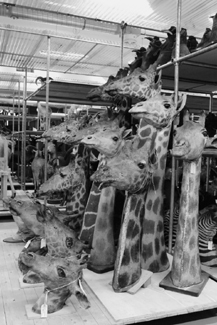
Giraffes’ heads stored behind the scenes as part of the zoology collections.
Stuffed giraffe specimens. Photo © Natural History Museum, London.
At the end of the corridor a small door led to a narrow, dimly lit staircase. It looked as if nobody had passed this way for years. At the top of the stairs was another curious little door, which bore the legend ‘THIS DOOR MUST BE LOCKED’. What secrets could be hidden behind it to require such inviolability? It opened out into a broad atrium, and across the way were some huge photographs of insects – beetles, I believe – and a fine formal entrance with double mahogany doors, above which was the notice ‘Department of Entomology’. I had passed through the Zoology Department into the kingdom of the insects. Who could resist the region of the hexapod, the realm of a different Keeper, the habitat of another batch of experts all tucked away from the world in this secret place? Through the doors and beyond there lay another vast empire of the natural world, rank upon rank of cabinets bearing labels identifying the family of insects to which the specimens belonged. I knew that there were further floors above me, and I had a brief vision of swarms of insects beyond number, as in films I had seen of plagues of locusts. Around the perimeter of this huge squarish gallery there were offices with names on doors, Dr This and Dr That, all presumably the authorities on the insects in the drawers that lined up in their thousands in ranks in front of me. Perhaps it was not surprising that the drawers themselves were only half as deep as those I had opened in the Palaeontology Department, because insects are mostly rather small, and you can fit a lot into a confined space.
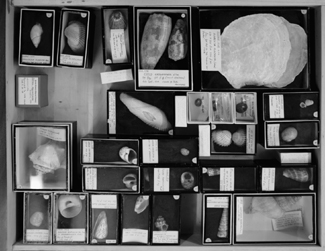
A tray of molluscs from the original Sloane collection that formed the nucleus of the Natural History Museum.
Tray of molluscs from the Sloane collection. Photo © Natural History Museum, London.
Still, opening one drawer at random, it was a surprise to find that there were dozens of butterflies inside, all neatly lined up, as if they were brooches in a jeweller’s shop. Every butterfly was pinned tidily through its thorax, with wings spread out to display the fore and aft pairs, each wing shimmering with iridescence as if it had met its death only minutes ago deep in the Amazon rainforest. Some specimens were laid out to show the underneath of the wings instead, which were brown-blotched and mottled, although no less intricate than the dorsal surfaces, if less spectacular. Pushing the drawer closed again, my gaze wandered along row upon row of similar ranks of drawers. Some part of me tried to do the arithmetic: there must have been about a hundred butterflies in the drawer I had been looking at. Multiply that by the number of drawers in the rank before me, and that number again by the number of cabinets – the mind soon began to reel as the noughts piled on. And to think that the butterfly specimens I happened to be examining were some of the largest and most spectacular of the Class Insecta – the Lepidoptera, the show-offs of the Entomology Department. To be sure, most insects are flies and small beetles, and maybe five times as many of these modest animals could be shunted away inside a single drawer. Many, many more of these insects must have been secreted away on other floors of the department. Hundreds of thousands soon became millions. I need hardly add that very few of these are on display.
My heady calculations were infused with the smell of naphtha, which provided a general fug throughout the Entomology Department. This is a chemical designed to keep away the pests that might otherwise gorge on the insects in the drawers – insects that eat long-dead insects. For of all the members of the animal kingdom the insects are endlessly inventive, experts at survival under almost any conditions, able to prosper where nothing else can earn a living. For some of them, the glue on an old label is a feast. When our own vainglorious species gets its eventual come-uppance – as it will – this will not disturb the cockroach (ah! So here are the Blattidae) one whit, nor jeopardize the prolific weevil, nor distract the swarming aphid. I soon learned that the very success of the insects poses the greatest problems to the entomologist. There are so many species, particularly in the tropics, that simply cataloguing and naming them all can seem an insurmountable task. There is still a long way to go, despite more than two hundred years of descriptive endeavour. We shall see later how scientific ruses have been suggested to get around this labour of Hercules. But, for now, I retreated back down the little hidden staircase into the familiar world of the basement of the Natural History Museum, and to the embrace of the trilobites.
Not far from my office door there is a tiny lift. A brass plaque in the lift informs the passenger that it was installed thanks to the beneficence of Prof. Oldfield Thomas FRS, and it certainly saved the poor curator from walking all around the galleries to get upstairs. I took the lift upwards to the third floor, where the all-purpose key had to be used again to let any passenger out. A kind of cage encloses the elevator’s inmates, and as it whizzes away there is an odd sensation of being carried upwards through solid walls. I emerged close by a cross-section through a great giant sequoia tree propped against the wall; this specimen had been displayed to the public ever since the early days of the Museum. I remembered seeing it as a child. Time was spelled out in the tree rings that circled the richly red wood. As evidence of the antiquity of the tree, human events were ticked off along one of its diameters at the appropriate number of annual tree rings. The tree was so big when America was ‘discovered’; it was of such and such a size when the Black Death stalked through Europe.
There is probably no more graphic way of comprehending earthly time than the stately chronometry of this tree. This one individual plant had seen more than a thousand years of modern human history, yet this was perhaps one-hundredth of the time since our species emerged from Africa. Then again, this life span of Homo sapiens (at most a hundred thousand years) was just a late sliver from the great trunk of geological time. The stretch of time life has been on Earth runs to at least 3.5 thousand million years. Or, if you prefer, more than a million times the age of the great arboreal Methuselah of living organisms that I was contemplating. Every specimen preserved in the Museum is a product of time, and evolution, cradled in the bosom of our planet. The Natural History Museum is, first and foremost, a celebration of what time has done to life. If the world is to remain in ecological balance, there is a pressing need to know about all the organisms that collaborate to spin the web of life. The planet’s very survival might depend upon such knowledge. I want to drag all the visitors to the Museum up to the tree and explain about time, and how we exist atop a vast history that has made us what we are, and that we ignore that history at our peril. But if I did, I fear that I should be branded with the same label as that funny old man who comes up in the street to tell you about his messages from angels.
Not far from the famous tree there is another of those locked doors. By now I knew what to expect. Behind the door there would be a further secret domain, and so it proved. This was the portal to the Herbarium, centre of the Department of Botany. Built almost at the top of the west end of the original Museum, it was the greatest surprise so far. I had become accustomed to the idea that behind the scenes I would find workaday spaces, functional and purposeful, but scarcely matching the grandeur of the public galleries. The Herbarium disabused me of that notion, for before me lay another grand hall, spacious and airy, illuminated naturally from skylights high above. Running along almost the whole length of the ‘nave’ of the hall (which indeed was as long as a large church) there were two ranks of polished hardwood cabinets. By now I knew what to expect of these – they would house the collections. And so it proved. Where a door was ajar I could see folders neatly stacked side by side in the cupboards, a different kind of collection from any I had seen so far. On tables between the cabinets some of the folders lay open for study: each one contained a number of herbarium sheets a couple of feet in length, on which were laid out pressed flowers; well, not just the flowers, but whole plants, leaves, stems and all. The one before me seemed to be a kind of Aquilegia, and it was spread out in the most delicate way, so as to display the beauty of its lobed leaves, and the pendent flowers. The fresh green colour of life had faded to a yellowish hue, tinged the colour of dry sherry. But the sheet had preserved the essence of the plant, much as a sepia photograph might preserve a Victorian street scene. There in immaculate copperplate script was the scientific name of the plant recorded by some long-retired curator – the date of collection showed that the plant had been pressed well over a century before, 24 May 1867. These herbarium sheets were clearly as permanent as the other collections I had seen, for all that the ‘fairest flower [is] no sooner blown but blasted’ as Milton said. Death could evidently be stopped in its tracks by using the correct procedures. Then all the archival information could be recorded on the same sheet of paper, not only the name and date, but also the locality, collector and identifier, and details of other specimens in the collection. Once more, I glanced along the rows of cabinets – and there were more on either side of the Herbarium – and tried to guess the vast number of records that must be stored in this great room. Since the herbarium sheet was little more than a slip of paper there would be dozens of specimens in a folder, many folders to a cabinet, and so on, apparently for ever. The mind soon went dizzy with the calculations. I learned recently that there are more than two million plants stored in the Botany Department.


